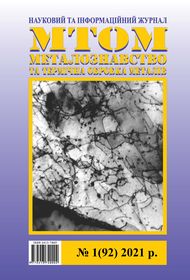Mathematical model of forecast of strength of low carbon steel
DOI:
https://doi.org/10.30838/J.PMHTM.2413.230321.49.734Abstract
Introduction. The use of different mathematical approaches to assessing and forecasting the quality characteristics of materials for different purposes is always relevant. The urgency of solving problems and problems of modern materials science with the use of methods of mathematical modeling allows to optimize technological processes of production, to determine in a short period of time the set parameters with minimal time and material costs. In the work using the method of regression analysis, the strength criteria of low-carbon low-alloy steel depending on the characteristics of the structure were evaluated. Materials and methods. Samples of Ст3пс steel grade made of a circle with a diameter of 24 mm were selected as the material for the study. The structure and mechanical properties were investigated at three reference points: at a distance of 0 mm from the center of the sample, 6 mm from the center of the sample and 12 mm from the center of the sample. The steel was investigated in the state of factory delivery, and after two modes of heat treatment to obtain ferritic-perlite and bainite structure. The following properties were determined: microhardness, tensile strength and yield strength, hardness and toughness at room temperature. The results of the experiment. Models for estimating mechanical properties were obtained using regression analysis. Models describing the relationship between the microhardness of pearlite and its area (R2 = 0.8366) in the state of factory delivery have a relatively high correlation coefficient; the score and the ultimate strength (R2 = 1.0) and yield strength (R2 = 0.8669) of steel after cooling in an oil medium; hardness and area of pearlite after hardening steel in the pearlite region (R2 = 0.7215). Conclusions. The practical significance of the work performed is the ability to perform a rapid analysis of the properties of rolled metal from steel Ст3пс based on determining the area of the structural elements and their scoring. However, it should be noted that the existing discrepancy between the results of the experiment and the forecast using the obtained models may be due to the influence of other factors. Such factors include the influence of chemical composition, incompleteness of formal axiomatics, which occurs when estimating the geometry of complex structural elements.
Keywords: low-alloy steel; structure; chemical composition; mechanical properties; regression model; properties forecast

Downloads
Published
Issue
Section
License
Authors that are published in this journal agree to follow the conditions:
Authors reserve the right to the authorship of his work and cede the right to the journal of first publication of this work on conditions of the license under the Creative Commons Attribution License, which allows others to distribute it freely with the obligatory reference to the author of the original work and the first publication of the work in this journal.
